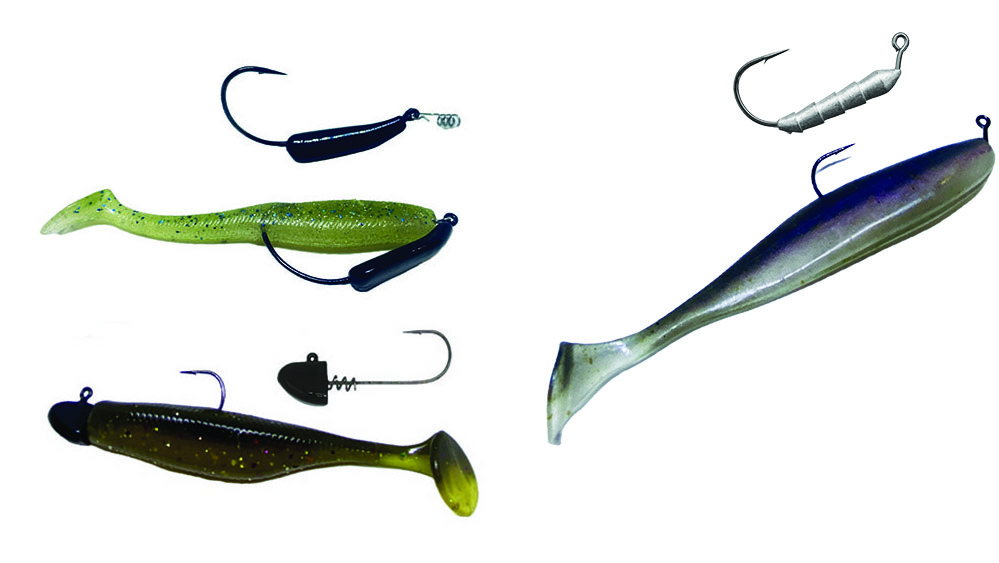The term gets this name simply because it joins lures and other tackle at or near the end of the fishing line. The word terminal according to Websters is junction or last, which lends to the overall meaning. However, I would submit that synonyms like critical, lethal or even fatal should be the way anglers look at terminal tackle. Let’s face it, the swivels, hooks and jigs we select for catching that trophy can literally be the critical point! It is the end of the line for the fish, or if the terminal tackle fails, a fatal mistake for the angler.
With terminal tackle being such a broad topic, our focus in this issue will be on tackle options for rigging and fishing swimbaits. If you fish for smallmouth, you likely realize the versatility of swimbaits. In chats with a wide variety of bass and walleye anglers, I have learned than many stick with one or maybe two rigging options. The hope for this article is to share a few of my favorite rigging options when fishing the swim profiles.
Swimbaits, or paddle-tails as they are often coined, range in a wide variety of sizes. And while I do play around with much larger swim profiles, the vast majority of my fishing involves those profiles in the 3 to 5 inch range. Shape, paddle size and softness open up a number of opportunities as to how, when and where. Along those lines, I tend to prefer softer, less durable swims when the water is cold and the bite is less aggressive.
In these situations, I move the swimbait extremely slow. The tails on softer baits just seem to paddle more freely with even just modest movement. Similarly in warm water conditions when bass are super active, harder more durable plastisol swims have a more desirable tail action at speed and simply hold up better for me. Most swimbait anglers have experienced a short strike early in the retrieval, where the swim is torn and pulled over the hook point. Or in some cases worse, where the tail is bitten off, killing the action and the chance for a follow-up strike. So regardless of your preference for ultra soft or more durable swims, these terminal tackle rigging options will help anglers get the most out of their day on the water.
Jig Masters Perfect Swim Sled
As an angler you know the scenario, you make that prefect cast on the edge of cover, give it a twitch only to have the bait slip off the keeper and waste the entire retrieve. It is bad enough, but the constant adjusting or rerigging after each cast is beyond frustrating. Swimbaits are very susceptible to aggressive short strikes that tear or pull the baits off the hook-keeper and around the hook. The softer the plastisol, the worse the issue. There are work arounds, but I have never been a fan of gluing swims on jigs. This works well enough but eventually the glue builds up and the jig is useless. I watch clients do this daily and ask if they would rather fish, than fuss.
This is when I break out the Perfect Swim Sled from Jig Master. Occasionally there comes a terminal tackle design that offers the solution, and not just a work around. Incorporating a coil keeper in the shaft of a ball, ned or swim jig is simply brilliant. Just spin your favorite swimbait on the shaft of the jig and you are set. I had my doubts early on, however getting 2 or even 3 times the number of fish on the same bait was eye opening. Especially with softer swims such as Keitech Easy Shiner or Megabass Spark Shad swims. Try them, you will thank me later.
Core Tackle Hover Rig
Hover fishing for smallmouth has been one of my favorite cold water fishing techniques for decades. In the early 2000’s, a good buddy and Reel River Associate guide, Curt Kirby and I would test a number of methods for Hover fishing a swimbait over schools of bass in the Susquehanna River. The technique is simple enough, find a school of fish and hover swim baits just above them. On the river, the amount of current and depth of the water would play a key role on getting the weight just right. If we couldn’t find the right jig weight, we would wrap and glue Twistons lead strips to the shaft of a bare jig hook to come up with the perfect weight combination based on the depth and current we were in. The rigs were never perfect and rigging the swim over the wraps was never as seamless as we wanted.
Core Tackle has solved this with their Hover Rig. The jig sits completely inside the swimbait so the weight is more neutrally balanced instead of completely forward. This gives the swimbait a completely different action, allowing it to hover over schools of fish. The jig comes in a variety of weights from 1/32nd ounce to 1/8th ounce to fit almost any current and depth combination necessary. The Core HD Hover Rig comes in 1/8th and ¼ ounce weights.
If you have not tried this method for bass and walleye, it is well worth the learning curve.
Fitt Premium Lures Flutterhead
If getting the swimbait through cover or over snags is an issue, Fitt Premium Lures has solved this with their Flutterhead jig. The jig was designed by Al Winco who wanted a keel shaped weight set back on a 60 degree worm hook so that the swimbait (and other soft plastics) could be rigged weedless. The baits are held in place by a coil keeper that is attached to the hook eye. With the keep shape of the weight and being shifted further back off the head of the jig, the swimbait flutters and drifts much like the Hover Rig. Especially when the bait is stopped and started back up again.
The Delaware and Susquanna Rivers are much like many eastern rocky rivers, Al wanted a jig that would snag-less than conventional exposed hook jigs. The shape of the keel weight comes through and over rocks better than most and the action is unbeatable.
The flutterhead Jig comes in weights from 1/8th to 3/8th ounce and in light-wire and heavy duty hooks. Anglers can get even more creative by rigging the Fitt Flutterhead jig with a willow blade on a snap-swivel. The underspin can be moved forward or back and locked into place with a Hook-All tool from Rapid Fishing Solutions. Give it a try.
Author Chris Gorsuch is a licensed charter guide in the state of Pennsylvania. He started the Reel River Adventures guide service in ‘07 and spends 225-250 days on the water annually. His home base is on the Susquehanna River where he operates 20’ jetboats.You can follow his daily fishing reports on Facebook ‘Reel River Adventures-RRA’ & Instagram @Chris_Gorsuch
While the subject of terminal tackle is generally not the most exciting topic. I do hope that some of these jigs combined with your favorite swimbait will produce a mess of bass and walleye in the coming season.



